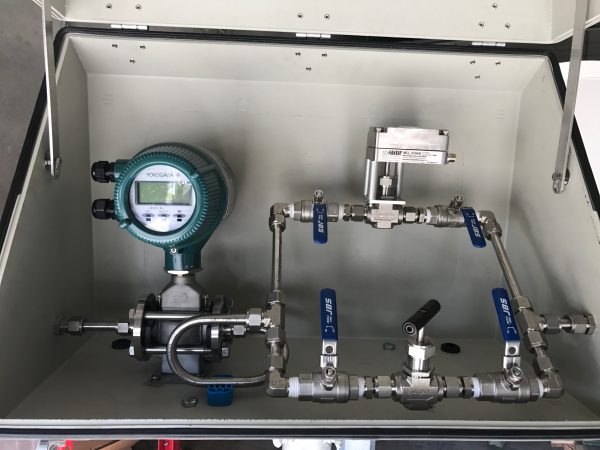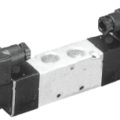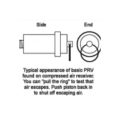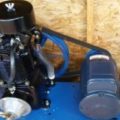Hey! This site is reader-supported and we earn commissions if you purchase products from retailers after clicking on a link from our site.
Valves are an integral part of any piping system, whether that be a compressed air system or for conveying liquids and other gases. They are typically used to control and regulate the media in question.
Needle valves and ball valves are two of the most common types of valves found across industries. They have significant differences in their design, mechanisms, applications, and more, and so, this article will provide you with all the relevant information on both!
Table of Contents
- What is a Needle Valve?
- What is a Ball Valve?
- Needle Valve or Ball Valve? The Key Differences
- FAQs (Frequently Asked Questions)
What is a Needle Valve?
Needle valves use a needle-shaped plunger to block the flow of the medium through the valve. They are typically controlled by a threaded rotating stem mechanism, providing the operator with fine control of the needle positioning.
Needle valves offer the ability to regulate flow in a variety of settings. The adjustable stem is capable of moving up and down at any point, allowing for positions where the valve is only half-open or partially open, allowing you to regulate the medium flow.
An obvious benefit of these levels of precision is the adjustment to flow rates which make needle valves popular for use in valve manifolds. Most needle valves are highly resistant to both hot and cold temperatures while also providing exceptional service life in high pressured environments.
Their high-pressure drop is often seen as allowing for an even easier control process, but high-pressure drops are not desirable, especially with compressed air systems. The pressure drop and precision control can also create a highly restricted flow, and so, needle valves are not ideal for high flow rate scenarios.
Here’s an example of a needle valve readily available on Amazon!
- ★Needle valve is an important part of the instrument measurement pipeline system, used to adjust the flow to the instrument or other industrial applications, open or cut off the pipeline path
Prices pulled from the Amazon Product Advertising API on:
Product prices and availability are accurate as of the date/time indicated and are subject to change. Any price and availability information displayed on [relevant Amazon Site(s), as applicable] at the time of purchase will apply to the purchase of this product.
Needle Valve Advantages
- Ability to withstand high pressure and vibrations
- Easy to shut-off
- Flexibility and adjustability
- Resisitant to hot and cold temperatures
Needle Valve Disadvantages
- Difficulty to tell when valve is open or closed
- Flow can become restricted due to a small passage between seat and needle
- High pressure drop
What is a Ball Valve?
Ball valves get their name from their ball-like design. They are often referred to as rotational valves, and in simple terms, they’re an on-off valve. Inside of a ball valve, in the center, you will find a ball with a channel through the center of it. By rotating the ball 90 degrees you expose this channel to the flow path and allow the medium to flow through the valve. By turning it 90 degrees again to a closed position, the flow is blocked off.
These type of valves are suited to applications where switching between fully open and closed states are regular and need an actuation that is quick. Ball valve designs provide excellent air-tight sealing capabilities and offer little worry about pressure drops for high-flow operations.
Ball valves are easy to tell when they are open or closed as their handles will lie flat and in the alignment of the flow when they’re open and then perpendicular to the flow when closed, making it easy to know the valve’s status.
- CHROME-PLATED BALL VALVE: Features a female threaded NPT connector for secure, leak-free connections
Prices pulled from the Amazon Product Advertising API on:
Product prices and availability are accurate as of the date/time indicated and are subject to change. Any price and availability information displayed on [relevant Amazon Site(s), as applicable] at the time of purchase will apply to the purchase of this product.
Ball Valve Advantages
- Cost-effective and reliable
- Durable
- Low pressure-drop
- Realiable sealing
- Resistant against contaminants
Ball Valve Disadvantages
- Liable to erosion when partially exposed
- Not suitable for precision flow control including throttling
Needle Valve or Ball Valve? The Key Differences
The most notable difference between a needle valve and a ball valve is that needle valves provide additional regulation opportunities that ball valves don’t. Needle valves offer precise control of flow and therefore, they are an ideal choice for calibration applications because they can be fine-tuned.
Needle valves are best suited to applications where a high degree of accuracy and control is important. A few examples of where needle valves are the better option include vacuum systems, metering systems, gas bleeder lines, sampling lines, and fluid power systems, all of which require precise flow regulation.
Needle valves are not suitable for situations that require rapid changes in the valve’s state. This is because moving through the full range of motion of the needle can often require numerous rotations of the screw handle, which can take some time.
On the other hand, ball valves have rapid actuation and minimal travel distance that make the valve ideal for some uses but certainly unsuitable for requiring precision flow control or extended throttling use.
Ball valves are suited to applications where a good sealing system is required. They are generally of lower cost and offer robust durability making them a very popular industrial choice along with their reliability in a closed position.
Ball valves are typically made from stainless steel and offer excellent corrosion resistance, and so, they will be found being used in the oil and gas, agriculture, manufacturing, mining, and construction industries.

FAQs (Frequently Asked Questions)
The better valve between the two typically depends on your application and requirements. Needle valves are better if you require a control valve, that can offer throttling capabilities. In contrast, ball valves are far better suited to applications that require frequent on/off switching.
The most evident difference between the two is their design. A ball valve has a sphere seated between a gasket. This sphere, or ball, normally has a through hole of same bore as that of inlet connection to allow flow when open. A needle valve has a tapered shaft, referred to as a needle, which presses against a seat. It is lowered or raised by a screw that is connected to the wheel or handle etc the top. Ball valves are used for switching between open and closed positions while needle valves offer control capabilities like throttling.
The advantage a needle valve offers is its flow control capabilities. Needle valves offer precise control of flow and the ability to regulate flow in a variety of settings. Their adjustable stem is can move up and down, allowing for half-open or partially open positions, resulting in the regulation of flow.
Globe valves are typically seen as the industry standard for regulating and controlling flow. However, there are many other valves that are suitable for flow control and these include needle valves, gate valves, pinch valves, and diaphragm valves.
Additional valve reading:
- Types of Compressed Air Valves – Guide To Pneumatic Valves
- Pneumatic Flow Control Valves – What Are They, How Do They Work?
- Air Compressor Air Line Non-Return valves/Inline (In The Air Line) Air Check Valves Explained
- Check Valve Sizes
- What is Check Valve Cracking Pressure
- Air Compressor Troubleshooting Check Valve
- Air Compressor Unloader Valve Explained
- Unloader Valves On Twin V Piston Compressor Guide
- 5 3 Valves Explained
- 5-2 Air Valves
- 4-2 Compressed Air Valves
- 3-2 Air Valves
- Drawing a 5/3 compressed air valve
- Draw A 5/2 Air Valve
- Pneumatic Soft Start Valves
- Solenoid Pilot Air Valves
- Compressed Air Solenoid Valve Guide
- Air Compressor Auto Drain Valves Guide
- Globe Valve vs Ball Valve
- Globe Valve vs Gate Valve
- Butterfly Valve vs Gate Valve
If you have any questions regarding ball valves vs needle valves, please leave a comment below, with a photo if applicable, so that someone can help you!







